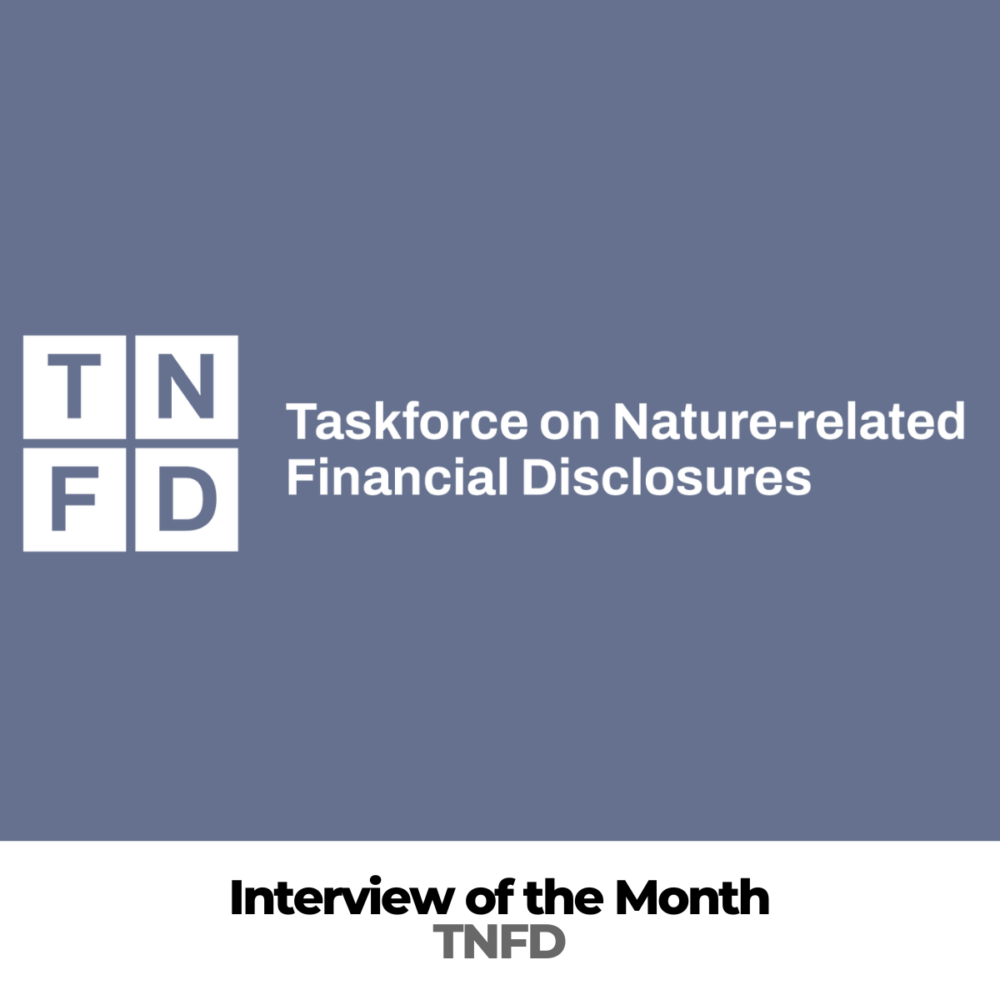
Interview of the Month : TNFD
In the wake of the Paris Agreement in 2015, the Financial Stability Board launched the Taskforce for Climate Related Financial Disclosure (TCFD) to improve and increase reporting of climate-related financial information by corporations and financial institutions. The reasoning was that financial markets need clear, comprehensive, high-quality information on the impacts of climate change. This includes the risks and opportunities presented by rising temperatures, climate-related policy, and emerging technologies in our changing world. Like the TCFD, the TNFD provides organizations with recommendations and guidance on a risk management and disclosure framework to act on evolving nature-related dependencies, impacts, risks and opportunities.
We interviewed the UN Global Compact Network for Switzerland and Liechtenstein, who lead the Swiss Consultation Group on the TNFD, on the occasion of their newly published recommendations for nature-related risk management and disclosure.
The Swiss Consultation Group is co-convened by both SSF and UNGCSL, with the aim of fostering a conversation between the financial industry and the real economy, supports the dissemination of the TNFD recommendations and additional guidance, identifies knowledge gaps in nature-related issues, and fosters capacity building for nature-related reporting across the local market.
How does the TNFD’s updated framework enhance the identification of nature-related risks and opportunities for businesses compared to previous versions?
Fabienne Sigg (Programme Manager at the UN Global Compact Network for Switzerland and Liechtenstein): The launch of the TNFD’s final recommendations for nature-related risk management and disclosure is a significant milestone, marking two years of design and development. These recommendations have undergone extensive refinement through an open innovation approach, involving collaboration with stakeholders worldwide.
In addition to the core recommendations, a comprehensive suite of supplementary guidance has been introduced to facilitate their adoption by market participants. This release is the culmination of an in-depth engagement process with a wide spectrum of stakeholders, including scientific and standards organizations. It draws upon the collective insights of 19 knowledge partners, as well as valuable input from over 1,200 institutions participating in the TNFD Forum across nearly 60 countries and territories. Moreover, the framework has been pilot-tested by over 200 companies and financial institutions, representing diverse sectors, biomes, and regions.
The journey of the TNFD from its inception to the recent launch has witnessed substantial refinements that notably strengthen the capacity to recognize nature-related risks and opportunities for businesses. These enhancements encompass the introduction of sector-specific guidance, the integration of forward-looking metrics, the expansion of reporting requirements, and the augmentation of stakeholder engagement mechanisms. Together, these refinements converge to forge a more robust framework for nature-related risk management and disclosure.
Could you provide a specific example of how the finance sector’s impact on businesses and societies relates to natural capital, and how TNFD’s recommendations address this impact?
Veronica Baker (Project Manager at Swiss Sustainable Finance): Natural capital is the stock of renewable and non-renewable natural resources, such as clean air, water, soils, minerals, plants and animals, that yield a flow of benefits to people . For the financial sector, the business within portfolios depends on natural capital and therefore risks posed to natural capital must be accounted for in a financial risk analysis, according to the TNFD’s recommendations. For example, a bank with a portfolio that includes business that are involved in agriculture, forestry and real estate development are heavily dependent on natural capital in the form of land, water and functioning ecosystems. The TNFD recommends that businesses consider nature-related impacts through several lenses. Firstly, there’s the governance lens, which involves engaging with companies to understand how their boards play a pivotal role in assessing and managing issues related to nature-related dependencies, impacts, risks, and opportunities. Secondly, the strategy lens prompts companies to consider how nature-related issues may influence their business model, overall strategy, and financial planning. Thirdly, the TNFD suggests adopting a risk and impact management lens, emphasizing the importance of the type and quality of metrics used to disclose their impacts, dependencies, and targets. Lastly, the TNFD encourages a risk management lens, which entails integrating nature and nature-related aspects into comprehensive risk assessments.
These multifaceted approaches collectively contribute to a more comprehensive understanding and management of nature-related factors within businesses over time, as more and more businesses disclose according to the TNFD, the quality of disclosures that a bank can make will improve. For the meantime, the TNFD recommends that financial institutions make disclosures on a sectoral basis.
Could you provide an overview of the core components of the TNFD recommendations, especially the recommended disclosures for nature-related issues and how these align with the four pillars of disclosure (Governance, Strategy, Risk Management, Metrics, and Targets)?
Veronica: The TNFD core recommendations consist of general requirements and a set of recommended disclosures. The TNFD has six general requirements; application of materiality, the scope of disclosures, the location of nature-related issues, integration with other sustainability-related disclosures, the time horizons considered and the engagement of indigenous people, communities and other affected stakeholders. These serve to act as guiding principles to keep in mind while considering nature interactions.
There are 14 recommended disclosures, consisting of the same 11 disclosures as in the TCFD (Taskforce on Climate Related Financial Disclosures) along with three additional ones for nature, which are split across the four pillars of Governance, Strategy, Risk & Impact Management and Metrics & Targets. These disclosures aim to list all the ways in which a business or financial institution may have interactions with nature, whereby the focus is always on nature-related dependencies, impacts on nature, risks resulting from interactions with nature and opportunities for interaction with nature.
In the Governance pillar there are three disclosures which illuminate the organisation’s governance of; in strategy there are four disclosures that look at the organisation’s business models, strategy and financial planning; in risk & impact management there are three disclosures focusing on how the organisation identifies, assesses, prioritises and monitors risks and opportunities; and in metrics & targets there are three disclosures that deep dive into the metrics and targets used by an organisation.
For each of these disclosures the TNFD offers a set of core metrics that apply to all sectors, as well as sector-specific core metrics and then an additional larger set of disclosure as assessment metrics that could be useful for more detailed disclosure.
Can you explain in more detail how the LEAP approach (Locate, Evaluate, Assess , -Prepare) is being integrated into the new recommendations and how it helps businesses and financial institutions better understand their relationship with nature?
Veronica: In order to be in a position to report on the recommended disclosures using appropriate metrics, the TNFD has created the so-called LEAP approach. The LEAP approach is a way to navigate through an organisation’s dependencies and impacts on nature and tackle them. Locate (L) means looking at where the interaction with nature is happening including the full scope of the business model and value chain and which of these locations are particularly vulnerable to loss and sensitive to change. This is a crucial element because nature is by definition natural and therefore has natural variation from place to place, meaning that any measure of biodiversity and the impact on natural systems is location-specific. Evaluate (E) entails identifying the exact environmental assets, ecosystem services and impact drivers in each of the locations identified in the L step. Then, dependencies and impacts of these systems can be identified, understood and evaluated to materiality. Asses (A) looks at risks and opportunities in detail and prepare (P) looks at how to respond and report these risks and opportunities. Responding can mean risks management, target setting, or portfolio management and reporting consists of decisions about how to report what has been measured, to whom to report it and how to present this report.
Fabienne: The LEAP approach is a valuable tool, drawing from various assessment methods, tools, and data sources already used by industry players. It enables a comprehensive assessment of nature-related issues, aligning impact materiality with GRI and ESRS requirements and financial materiality in line with ISSB’s approach. Ultimately, it empowers businesses and financial institutions to better navigate their nature-related challenges and opportunities.
In what ways does TNFD’s framework complement or align with existing reporting architectures, and how does it contribute to the evolving landscape of sustainability reporting?
Fabienne: The TNFD’s framework aligns with globally recognized sustainability reporting standards, established by ISSB and GRI, promoting a unified approach across industries. Additionally, it builds upon the TCFD’s recommended disclosures, seamlessly incorporating all 11 TCFD disclosures into the nature context. This alignment ensures that businesses can seamlessly incorporate nature-related considerations into their existing reporting practices while adhering to established global reporting standards.
Furthermore, the TNFD recommendations are designed to accommodate diverse materiality approaches, including those outlined in the European Sustainability Reporting Standards (ESRS). This adaptability allows companies to effectively navigate varying materiality frameworks across different jurisdictions, promoting the framework’s applicability in diverse regulatory contexts.
Lastly, the TNFD’s alignment with the Kunming-Montreal Global Biodiversity Framework underscores its commitment to global sustainability objectives and biodiversity preservation. By harmonizing with these international goals and enhancing disclosure consistency, the TNFD framework empowers businesses to play a vital role in conserving biodiversity on a global scale, contributing to a more sustainable future for all stakeholders.



